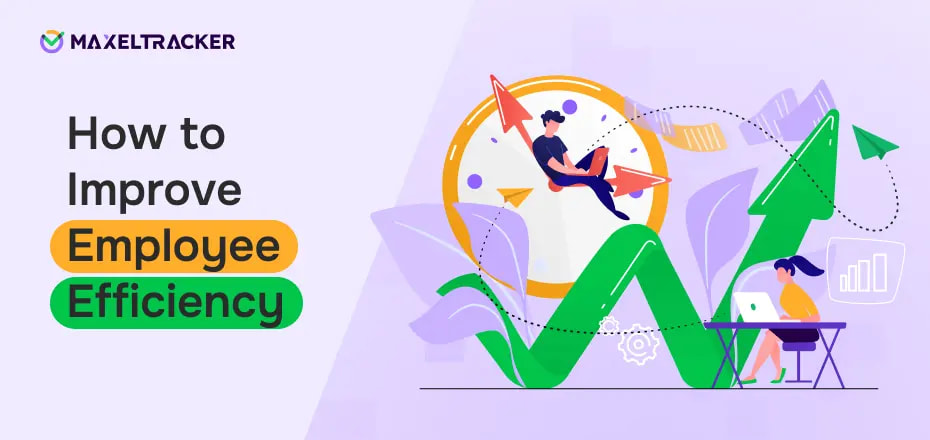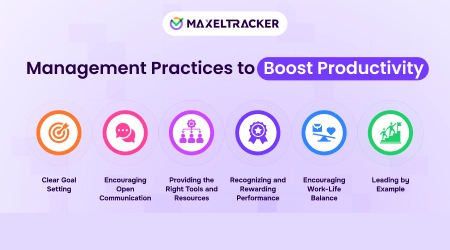

Employee efficiency is a cornerstone of business success. While productivity is often measured by the sheer amount of output, efficiency emphasizes achieving high-quality results while making the best use of time and resources. In other words, an efficient employee not only produces work but does so with minimal waste—optimizing both effort and outcomes.
This post outlines key strategies to boost employee efficiency, covering everything from understanding what efficiency means in today’s workplace to utilizing technology to streamline processes. Whether you’re managing remote teams or a specialized department like sales or software development, these strategies can be tailored to improve performance and drive better business results.
Employee efficiency refers to an employee's ability to accomplish the most work in the least amount of time. However, it’s important to differentiate employee efficiency from employee productivity, which typically focuses on sheer quantity of tasks completed. Efficiency also emphasizes quality, meaning that an employee must deliver a substantial volume of high-quality work to be considered efficient. The definition of quality can vary based on factors unique to your organization.
Employee efficiency may look different depending on an individual’s knowledge, skills, and experience. Nonetheless, this core understanding of employee efficiency provides a framework for discussions on performance and improvement.
Employee efficiency and workplace efficiency both focus on the productivity and quality of work produced by individual employees. The key difference between the two is that employee efficiency typically refers to the performance of a single worker, while workplace efficiency looks at the collective efforts of an entire team or department.
In both cases, employee productivity is a common measure of efficiency, as it gauges the output of work relative to the time and resources used. Whether you're looking to enhance individual or team efficiency, gathering metrics on how employees work can help you identify specific areas for improvement.
Several factors affect employee efficiency on a micro level, such as a positive work environment, personal motivations, level of engagement, satisfaction, and competencies.
Understanding what's happening within your organization during a specific time period is a good starting point. However, the real value in measuring and tracking employee performance lies in taking a long-term approach. Monitoring employee efficiency over time becomes manageable when you're organized.
Follow these four steps to create an effective employee efficiency plan:
The first step in developing a workforce efficiency measurement plan is to establish clear standards. This planning phase can be challenging for many managers, as it requires creating unique standards for every position and project, ensuring clear goals, objectives, and reasonable expectations for all team members.
For each task, define the target goals and metrics you plan to track. Some example data points to consider include:
Usual work hours per week: Are you tracking how long it takes to complete projects and tasks? Do you have enough lead time to anticipate overtime needs?
Number of revisions required per project: What does this reveal about potential gaps in training?
Email response times: How long does it take for employees to respond to emails? Does your team have access to helpful documentation, support articles, or FAQs?
Employee absenteeism rate: Are employees given adequate time off, and is it easy for them to request it?
Tracking employee idle time provides real-time visibility into how efficiently individuals and teams complete tasks. An effective time tracking system should capture data for both in-house and remote teams. Key metrics to consider include:
Clock-in and clock-out times
Time spent on non-work-related activities (e.g., personal emails, social media)
Overtime hours worked
Daily work schedule consistency
Percentage of work completed within target ranges
Time-off requests
Time spent on assigned tasks
Measuring the quality of work requires a more nuanced approach, as quality is subjective. While there is no one-size-fits-all formula for measuring business-specific quality targets, certain metrics can provide valuable insights:
QA inspection pass/fail rates: How many products or projects pass or fail quality checks?
Customer feedback: The number of complaints or positive reviews can indicate an employee’s performance.
Employee engagement and satisfaction: Using surveys like eNPS (Employee Net Promoter Score) or 360-degree feedback offers helpful insights.
Realized Project Value (RPV): Calculate the RPV by dividing the percentage of work completed by the approved or working project budget. This helps evaluate if the project is on track in terms of efficiency. A project running over budget early on may indicate efficiency issues.
To calculate efficiency over time, assess which employees and processes deliver the highest value for the least amount of time. By applying the metrics and formulas discussed above, organizations can get a snapshot of efficiency at any given moment. Over time, this will highlight trends in employee efficiency and areas that need improvement.
By regularly tracking these metrics, you can continuously refine your strategies to boost employee and team efficiency across the board.
Calculating an employee’s efficiency involves assessing how much time is spent on actual work, rather than just the total time an employee is on the clock. This allows for a more accurate evaluation of performance, considering both productivity and focus.
To calculate employee efficiency, you'll typically use two metrics: productivity ratio and efficiency score. The productivity ratio helps measure output, while the efficiency score accounts for the amount of time spent on productive tasks.
Let’s consider an example: A book reseller requires each employee to process five orders per hour, and each employee works an eight-hour shift. If an employee spends two hours on non-work activities (such as breaks, training, or other interruptions), their workday is effectively reduced to six productive hours.
Employee Productivity Formula
To calculate the productivity ratio, use the following formula:
Productivity Ratio = (Actual Output ÷ Target Output) × 100
For example, if the employee processes 30 orders out of the target of 40 orders, the formula would be:
30 orders ÷ 40 orders = 0.75 × 100 = 75% productivity ratio
This shows that the employee achieved 75% of the target output, meaning they could increase their order processing by 25% to meet the target.
Employee Efficiency Formula
To determine the efficiency score, which provides a broader view of the employee’s time management and effectiveness, you use this formula:
Efficiency Score = (Productive Time ÷ Total Scheduled Time) × 100
In our example:
Efficiency Score = (8 hours – 2 hours) ÷ 8 hours = 6 hours ÷ 8 hours = 0.75 × 100 = 75% efficiency
This tells us that, despite the employee being scheduled for 8 hours, only 75% of their time (6 hours) was spent on productive tasks.
Though it may seem counterproductive, scheduling regular breaks during the workday can significantly boost employee efficiency. When employees take unscheduled breaks to check social media or chat with colleagues, it disrupts their workflow and makes it harder to refocus. By providing designated break times, employees can recharge and return to work with renewed energy, allowing them to be more focused and minimize distractions throughout the day.
When employees are stressed, overworked, or unwell, their ability to produce high-quality work diminishes. Managers should implement programs that support employees' mental, physical, and emotional well-being. In addition to offering healthy snacks or discounted gym memberships, it’s important to foster a culture of work-life balance and help employees avoid burnout. Leading by example is key — take breaks, avoid checking work emails after hours, and encourage mental wellness days when necessary.
Over Time tracking tools can also help identify employees working excessive hours, enabling managers to promote healthier work habits. Research shows that people often underestimate the time spent working. Remind employees that working longer hours doesn't always translate to better efficiency; self-care is equally important for long-term productivity.
Offering flexible working hours can greatly increase employee efficiency by allowing individuals to work during their most productive hours. It also shows employees that you trust them, enhancing their sense of value and boosting job satisfaction. Providing flexibility in work schedules can contribute to higher engagement and productivity levels.
Every employee has unique strengths. While onboarding should provide all employees with the necessary knowledge and skills, it’s essential to recognize individual talents and assign tasks accordingly. Understanding where employees excel allows you to delegate responsibilities that align with their skillsets, improving both efficiency and quality of work. Performance reviews or data-driven insights can help identify employee strengths and weaknesses, providing a clearer picture for better task allocation.
Incentives are powerful motivators that show employees their hard work is recognized. Acknowledging achievements helps employees feel appreciated and can drive higher efficiency. While raises and bonuses are common incentives, there are other ways to reward employees, such as:
Offering extra vacation days
Allowing employees to start their day later or finish earlier once a week
Publicly praising their efforts in meetings or via email
Sending personalized thank-you notes
Treating them to a free lunch
Boosting team efficiency and productivity requires clear insights, effective planning, and the right tools. MaxelTracker helps organizations achieve this by offering detailed performance insights and employee productivity tracking features that support better decision-making. Here's how MaxelTracker can improve your team's efficiency:
MaxelTracker tracks time spent on various tasks and applications, giving managers a clear understanding of where employees are investing their time. By identifying time-consuming activities, you can make adjustments to improve productivity.
With features like app categorization and department-wise insights, MaxelTracker highlights productive and unproductive behaviors. This allows HR teams to assess trends, address challenges, and guide employees toward more effective work practices.
MaxelTracker's live screen monitoring feature allows employees to manage their work hours efficiently, helping them allocate time to priority tasks and maintain focus during key work periods.
By capturing screen activity with blur options, MaxelTracker provides managers with useful insights into employee performance without compromising sensitive information.
MaxelTracker’s weekly productivity alerts notify employees whose performance may be declining, encouraging them to connect with HR for support. This proactive approach helps teams maintain focus and motivation.
For remote or hybrid teams, MaxelTracker’s geo-location tracking feature helps managers understand where employees are working, ensuring accountability without micromanagement.
Remote work presents its own set of challenges, but with the right approach, it can be just as efficient, if not more so—than working in an office.
Even without a physical office, structure remains essential. Encourage remote employees to establish daily schedules, create a designated workspace, and build consistent routines. A clear structure helps employees stay focused and organized, making remote work more efficient.
Utilize digital tools such as video conferencing, instant messaging, and cloud-based project management software to maintain communication and monitor progress. These tools are essential for improving remote employee efficiency, ensuring that teams stay aligned and productive despite geographical distances.
Set up regular one-on-one and team meetings to address challenges, celebrate successes, and make sure remote employees feel connected and supported. Consistent check-ins help reinforce goals, clarify expectations, and boost engagement.
Shift the focus from the time employees spend online to the quality and quantity of the work they deliver. This approach builds trust and allows remote workers to take ownership of their tasks, resulting in higher motivation and productivity.
Sales teams operate in a fast-paced environment where efficiency directly impacts performance and the bottom line. Here are key strategies to boost sales team efficiency:
A comprehensive Customer Relationship Management (CRM) system helps streamline lead tracking, automate follow-ups, and provide valuable insights. By reducing administrative tasks, sales professionals can focus more on closing deals and less on manual processes.
From scheduling meetings to sending follow-up emails, automation tools can eliminate repetitive tasks and save valuable time. This significantly enhances the efficiency of the sales team, allowing them to focus on high-impact activities that drive results.
Continuous learning is crucial for a high-performing sales team. Regular training on new sales techniques, market trends, and product knowledge helps sharpen skills and improve efficiency, allowing the team to refine their strategies and increase performance.
Analyzing sales data reveals valuable trends, forecasts, and areas for process optimization. By leveraging data insights, sales teams can fine-tune their strategies and improve their efficiency, leading to better decision-making and more successful sales efforts.
For software development teams, efficiency means delivering quality code faster without sacrificing innovation.
Agile frameworks such as Scrum or Kanban break projects into smaller, manageable tasks, allowing teams to adapt quickly to changes and continuously improve their processes.
Automation can take care of repetitive coding tasks, testing, and integration processes, which reduces errors and speeds up development cycles.
Frequent peer reviews not only improve code quality but also foster a culture of learning and continuous improvement.
Ensure that every team member is clear about their responsibilities and that workflows are streamlined to minimize delays. Addressing questions like how would you increase the efficiency of your development team? involves refining processes and investing in tools that support collaboration and rapid iteration.
Employee efficiency is a strategic driver of business success. By understanding the nuanced difference between mere productivity and true efficiency, organizations can set clear standards, track performance, and calculate efficiency accurately. Embracing long-term metrics and technology-driven tools—like MaxelTracker—empowers managers to identify improvement opportunities across individual, team, remote, sales, and development functions. Ultimately, integrating flexible work practices, promoting well-being, and aligning tasks with employee strengths creates a culture of continuous improvement, driving sustainable growth and a competitive edge.
👉 Sign up now at MaxelTracker.com and start transforming your team’s productivity today! 🚀
👉 Explore our pricing plans and features to find the perfect solution for your team’s productivity needs! 🚀
Related Blogs

Employee Productivity Dashboard Every Organization Needs
Managing today’s teams means juggling moving deadlines, hybrid work setups, and higher-than-ever expectations. When updates are scattered across different tools or passed along secondhand, it slows everyone down and puts project success at risk.

How to Track Productivity of an Employee Working from Home?
Remote work is no longer a trend—it's the new norm. Businesses now need clear, efficient ways to track productivity without micromanaging. When employees work from home, traditional supervision is gone.

Top Management Practices That Can Improve Employee Productivity
Strong management drives workplace efficiency. Employees perform better when leaders provide structure, support, and clear expectations. Without effective management, teams struggle with miscommunication, low motivation, and wasted time.